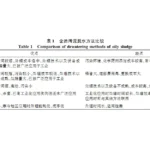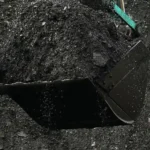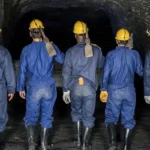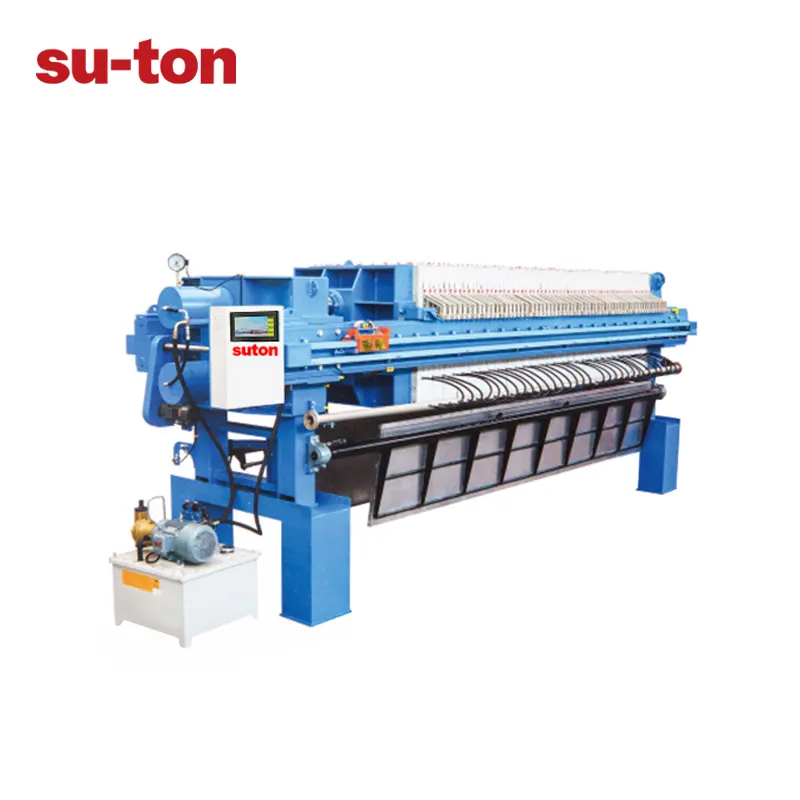introductory
1. History of filter presses
filter pressIt is a mechanical equipment that uses a special filtering medium to exert a certain pressure on the object to make the liquid ooze out. It is a commonly used solid-liquid separation equipment. it was used in chemical production in the early 18th century, and is still widely used in chemical, pharmaceutical, metallurgy, dyestuff, food, brewing, ceramics, environmental protection and other industries. Stable performance, convenient operation, safety and energy saving; metal pressure cylinder adopts seamless steel pipe processing, plastic steel filter plate melt casting moulding, high temperature and high pressure resistance, durable. The filtering mechanism consists of filter plate, filter frame, filter cloth and pressure membrane. Both sides of the filter plate are covered with filter cloth. When the membrane pressure is required, a group of filter plates is formed by the membrane plate and the side plate. The bottom plate of the membrane plate is covered with rubber diaphragm on both sides, the outside of the diaphragm is covered with filter cloth, and the side plate is an ordinary filter plate. Solid particles are trapped in the filter chamber because their size is larger than the diameter of the filter medium, and the filtrate flows out of the outlet hole under the filter plate. When the filter cake needs to be pressed dry, in addition to diaphragm pressing, compressed air or steam can be introduced from the washing port, and the airflow is used to flush the water out of the filter cake, thus reducing the water content of the cake. Filter cloth is a main filter medium. The selection of filter cloth plays a decisive role in the filtration effect. When selecting the filter cloth, the appropriate material and pore size of the filter cloth should be selected according to the pH value of the filter material, the size of the solid particles and other factors, in order to ensure low filtration cost and high filtration efficiency.
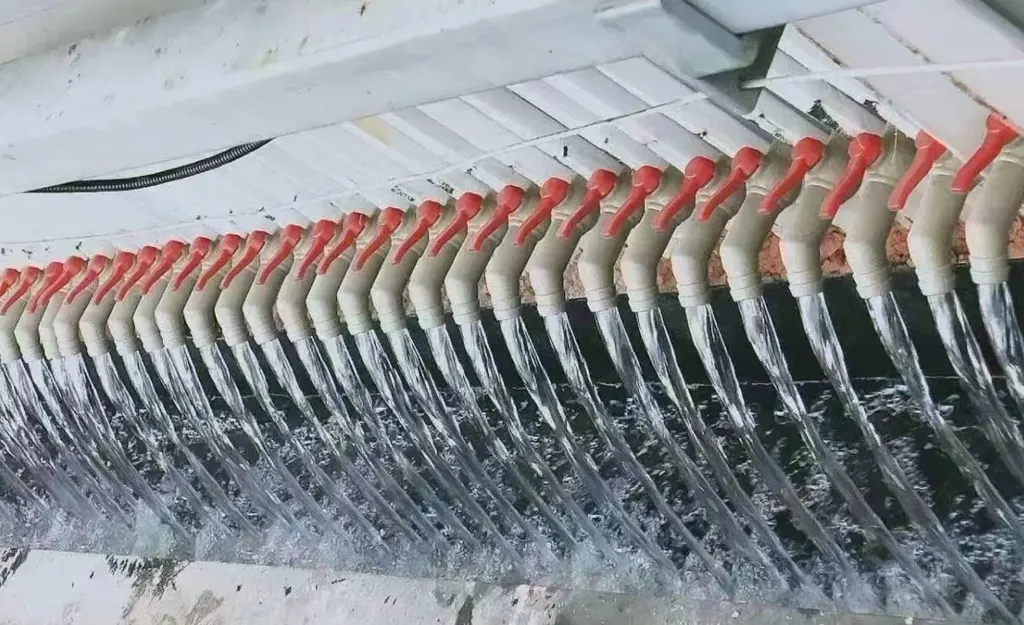
2 Plate and frame filter presses
Consists of alternately arranged filter plates and frames. The plates and frames are supported on a crossbeam by means of handles on both sides. The surface of the filter plate has grooves for supporting and covering the filter cloth. The compression plate moves and a thrust plate secures the compression plate and frame and forms a filter chamber between the plate and frame. The filter plate and frame have through holes in the corners and form a complete channel when assembled. The pressurised material can enter the filtration chamber through this channel. After the filtrate passes through the filter cloth, it is discharged through the channel on the surface of the filter plate. After the filtration is completed, fresh water can be passed through to wash the filter residue. After washing, the remaining washing liquid is sometimes removed by compressed air. The compression plate is then opened to remove the filter residue, clean the filter cloth, re-compress the plate frame, and so on.
3 chamber filter presses
The structure and working principle of chamber filter press is similar to that of plate and frame filter press, the difference is that the two sides of the filter plate are concave, and every two filter plates are combined to form a chamber, eliminating the filter frame, and there is a round hole in the centre of the filter plate. The suspension thus flows into the chambers. This type of filter is suitable for suspensions that need to be filtered under high pressure without washing of the filter residue. Vertical filter press filter plates are stacked horizontally and up and down to form a group of filter chambers, covering a small area. It adopts a continuous filter belt, after completing the filtration, the filter belt is moved for discharging slag and washing the filter belt, and the operation is automated.
4Filter Press Principle
4.1 Filter presses consist of plate and frame filter presses, chamber filter presses and diaphragm filter presses.
4.1 The working principle of the filter press filter press on the form of filter plate, there are chamber and plate and frame type of points; on the filter plate placed in different positions, there are vertical and horizontal points;
4.2 The filter plate material is different, there are plastic, rubber, cast iron, cast steel, carbon steel, stainless steel; on the filter plate whether to configure rubber squeeze film, there are squeeze dehydration and not squeeze dehydration points;
4.3 Filter plate configuration filter cloth surface number of different, there is a single side of the dehydration and double-sided dehydration points, etc..
4.3 Feeding mode and separation, regardless of what kind of filter press, its working principle is first of all positive pressure dewatering, also known as slurry dewatering, that is, a certain number of filter plates in the role of strong mechanical force is tightly lined up in a row, the filter plate surface and between the surface of the plate to form a filter chamber, filtering materials in a strong positive pressure is sent to the filter chamber, into the chamber of the filter material and its solid part of the filter media (such as filter cloth) intercepted to form a cake, the liquid part through the filter media and out of the filter chamber, so as to achieve the purpose of solid-liquid separation. The solid part of the filter material is retained by the filter medium (such as filter cloth) to form filter cake, and the liquid part is discharged from the filter chamber through the filter medium, so as to achieve the purpose of solid-liquid separation, with the increase of positive pressure, the solid-liquid separation is more complete, but from the aspect of energy and cost considerations, it is not cost-effective to have too high positive pressure. Into the pulp dewatering, equipped with a rubber squeeze membrane filter press, the compressed medium (such as gas, water) into the back of the squeeze membrane to push the squeeze membrane to make the squeeze cake further dewatering, called squeeze dewatering. After slurry dewatering or extrusion dewatering, compressed air enters the side of the filter chamber through the filter cake, carrying liquid water from the other side of the filter cake through the filter cloth out of the chamber and dewatering, called air-blown dewatering. If both sides of the filter chamber are covered with filter cloth, the liquid part can be discharged from the filter chamber through the filter cloth on both sides of the filter chamber, which is called double-sided dewatering of the filter chamber. After dewatering is completed, the mechanical compression force of the filter plate is lifted, and the filter plate is gradually pulled away from the single piece, and the filter chamber is opened to unload the cake for the completion of a major work cycle. According to the different nature of filtering materials, the filter press can be set up into the pulp dehydration, extrusion dehydration, air dewatering or single and double-sided dewatering, the purpose is to minimise the water content of the filter cake.
4.4 Filtration mode: the way of filtrate outflow is divided into open-flow filtration and dark-flow filtration. Open flow filtration, each filter plate is equipped with water nozzle on the lower outlet hole, the filtrate intuitively from the water nozzle. Concealed flow filtration, each filter plate is equipped with a liquid channel hole below, a number of filter plate liquid hole connected to a liquid channel, by the filter plate below the liquid hole connected to the pipeline discharge.
4.5 Washing mode: when the filter cake needs washing, there are time flow one-way washing and two-way washing, dark flow one-way washing and two-way washing. Open-flow unidirectional washing is that the washing liquid enters from the washing liquid inlet hole of the thrust plate in turn, passes through the filter cloth and then through the filter cake, and flows out from the non-perforated filter plate, at this time, the outlet nozzle of the perforated plate is in a closed state, and the outlet nozzle of the non-perforated plate is in an open state. Open flow bidirectional washing is, the wash liquid from the thrust plate above the two sides of the wash liquid into the hole has been washed twice, that is, the wash liquid first from one side of the wash and then from the other side of the wash, the wash liquid with the import of the outlet is diagonal direction, so also known as bidirectional cross-washing. Concealed unidirectional flow washing is, the wash liquid from the thrust plate wash liquid into the hole in turn into the perforated plate, through the filter cloth and then through the cake, from the non-porous filter plate out. Concealed flow bidirectional washing is the wash liquid from the stop plate on both sides of the two wash liquid inlet holes successively twice, that is, washing first from one side, and then from the other side of the wash, the wash liquid outlet is diagonal direction, so it is also known as the concealed flow of bidirectional cross-washing. Classification of Filter Press Plate and Frame Filter Press consists of alternately arranged filter plates and frames to form a group of filter chambers. The surface of the filter plate has grooves, and its protruding parts are used to support the filter cloth. There are holes on the corners of the filter frame and the filter plate, which form a complete channel after assembly, and can pass into the suspension, washing water and lead out the filtrate. Each side of the plate and frame has its own handle to support on the beam, and the plate and frame are pressed by the pressing device. The filter cloth between the plate and frame acts as a sealing gasket. Suspension pressure is fed into the filter chamber by the feed pump, and slag is formed on the filter cloth until the filter chamber is full. The filtrate flows through the filter cloth and along the grooves of the filter plate to the corner channel of the plate and frame, and is discharged centrally. After filtration, the filter residue can be washed with washing water. After washing, sometimes compressed air is also passed to remove the remaining washing liquid. Subsequently, open the filter press to remove the filter residue, clean the filter cloth, re-press the plate and frame, and start the next working cycle. Plate and frame filter presses are suitable for suspensions where the slag is highly compressible or nearly incompressible. Suitable for the suspension of solid particles concentration is generally below 10%, the operating pressure is generally 0.3 to 0.6 MPa, special up to 3 MPa or higher. The filtration area can be increased or decreased with the number of plates and frames used. The plate and frame are usually square, the inner side of the frame is 200-2000mm long, the thickness of the frame is 16-80mm, and the filtering area is 0.5-1200 metres. The plate and frame are pressed by manual screw, electric screw and hydraulic pressure. The plates and frames are made of wood, cast iron, cast steel, stainless steel, polypropylene and rubber.
4.6 Compression mechanism: the compression mechanism includes manual compression, mechanical compression and hydraulic compression. Manual compression is a spiral mechanical jack to push the compression plate to press the aluminium plate. Mechanical compression compression mechanism by the motor (equipped with advanced overload protector) reducer, gear payment, screw and fixed. Nut composition. When pressing, the motor turns positively, driving the reducer, gear payment, so that the silk rod rotates in the fixed nut, pushing the pressing plate to press the filter plate and filter frame tightly. When the compression force is getting bigger and bigger, the load current of the motor increases, when it reaches the current value set by the protector, it reaches the maximum compression force, the motor cuts off the power supply and stops rotating, due to the fact that the silk rod and the fixed silk mother have reliable self-locking helix angle, it can reliably guarantee the compression state in the process of working, and when returning, the motor reverses, and stops when the pressure block on the compression plate touches the travelling switch and returns to the stop. Filtering mechanism: The filtering mechanism consists of filter plate, filter frame, filter cloth and pressing diaphragm, both sides of the filter plate are covered by the filter cloth, and when it is necessary to configure the pressing diaphragm, a set of filter plate consists of the diaphragm plate and the side plate. The base plate of diaphragm plate is covered with rubber diaphragm on both sides, the outside of diaphragm is covered with filter cloth, and the side plate is the ordinary filter plate. The material enters into each chamber through the plastic holes on the thrust plate, the solid particles are retained in the chamber because their particle size is larger than the aperture of the filter medium (filter cloth), and the filtrate flows out from the outlet holes under the filter plate. When the filter cake needs to be squeezed dry, in addition to the diaphragm press, compressed air or steam can also be used, from the washing port into the airflow to wash away the water in the cake, in order to reduce the water content of the cake. Filter cloth: Filter cloth is a main filtering medium, the selection and use of filter cloth has a decisive role in the filtration effect, the selection should be based on the PH value of the filtered material, solid particle size and other factors to choose the appropriate filter cloth material and aperture in order to ensure that low filtration costs and high filtration efficiency, the use of the filter cloth to ensure that the filter cloth is flat and not folded, the aperture of the free flow.
5 Filter Press Applications
Filter press application fields of mineral processing industry: With the development of modern industry, mineral resources are increasingly depleted, the mined ore has been faced with "poor, fine, miscellaneous" situation, for this reason, people have to grind the ore to be finer, and the "fine, muddy, viscous" material for the Solid-liquid separation. Nowadays, in addition to the high demand for energy saving and environmental protection, the enterprise solid-liquid separation technology and equipment and put forward a higher and broader requirements. For mineral processing, metallurgy, petroleum, coal, chemical, food, environmental protection and other industries, social demand, pulling the application of solid-liquid separation technology and equipment, and the breadth and depth of its application areas are still expanding.
6 Filter Press Development
The reason why the filter press can flourish and is widely used by various industries, its greatest superiority is the positive pressure, high pressure pressure dewatering, compared with the traditional vacuum filter pressure difference is much larger, and thus the cake moisture is low, less energy consumption, less loss of metal, the filtrate is clear and transparent. As early as more than ten years ago, some experts pointed out that the filter press is currently the only one of all industrial filters that can ensure that the water content of the filter cake reaches less than 10%, and can be used without flocculant. Sewage treatment industry: the flocculated sludge is transported to the belt filter press, where the free water is separated under the action of gravity, forming the sludge in non-flowing state, and under the action of squeezing force and shear force, the sludge is squeezed gradually, and finally the filter cake is formed and discharged. It is widely used in sewage treatment of urban domestic sewage, textile printing and dyeing, electroplating, papermaking, leather, brewing, food processing, coal washing, petrochemical, calcium carbide slag, starch residue, wine residue, textile activated sludge and other industries.
Disclaimer: The copyright of this article belongs to the original author and the original source.
Welcome to call us for consultation, technical exchange, and material experiment.
 Plate and frame chamber diaphragm filter presses
Plate and frame chamber diaphragm filter presses

